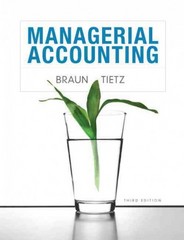Question
Prakash & Co. provides you with following data : Total overhead ` 30,10,500 Total machine hrs. 2,23,000 Production : Product L 10,000 units Product M
Prakash & Co. provides you with following data : Total overhead ` 30,10,500 Total machine hrs. 2,23,000 Production : Product L 10,000 units Product M 3,000 units Product N 2,10,000 units Direct cost per unit Selling price per unit Product L ` 20 ` 50 Product M 20 45 Product N 9 40 The profit of this company is ` 38,74,500. The overhead has been distributed at the rate of ` 13.50 per machine hour and each unit produced in the company is presumed to have used one machine hour. The Manager Finance has reported that all the units are profit-making. Direct Finance wants to implement Activity Based Costing. The further information in this regard are as follows : i. The overhead is caused by following activities : (a) Set -up - 1,37,600 set-ups to be charged @ ` 10 per set-up ` 13,76,000 (b) Machining - 51,800 machine hours to be charged @ `15 per machine hrs. 7,77,000 (c) Engineering - 24,750 engineering hrs. to be charged @ ` 20 per hr. 4,95,000 (d) Organistaion costs cannot be linked with products 3,62,500 30,10,500
ii. Based on the basis of factory records it is established that activities have been assigned to different products as follows :
Set-up (hrs.) Machining (hrs.) Engineering (hrs.)
Product L 8,000 6,000 1,500
Product M 3,600 3,800 2,250
Product N 1,26,000 42,000 21,000 1,37,600 51,800 24,750
Director Finance expects you to answer following questions :
i. What are the profits made by different products, when conventional costing method of overhead distribution is used and overall profit is ` 38,74,500?
ii. (a) What will be the profit of different products, if ABC costing is used presuming that the information given are reliable?
(b) Can we discontinue any product, if discontinuing a loss-making product does not harm the organization otherwise? What will be increase in profit, if loss-making product is discontinued?
(c) Reasons for difference in results shown by conventional costing and Activity - Based Costing system.
A large Company is organized into several manufacturing divisions. The policy of the Company is to allow the divisional Managers to choose their sources of supply and when buying from or selling to sister divisions, to negotiate the prices just as they will for outside purchase or sales.
Division X buys all of its requirement of its main raw material R from Division Y. The full manufacturing cost of R for Division Y is ` 88 per kg. at normal volume. Till recently, Division Y was willing to supply R to Division X at a transfer price of ` 80 per kg.
The incremental cost of R for Division Y is ` 76 per kg. Since division Y is now operating at its full capacity, it is unable to meet the outside customers' demand for R at its market price of ` 100 per kg. Division Y, therefore, threatened to cut off supplies to Division X unless the latter agrees to pay the market price for R.
Division X is resisting the pressure because its budget based on the consumption of 1,00,000 kg. per month at a price of ` 80 per kg. is expected to yield a profit of ` 25,00,000 per month and so a price increase to ` 100 per kg. will bring the Division X close to break-even point.
Division X has even found an outside source for a substitute material at a price of ` 95 per kg. Although the substitute material is slightly different from R, it would meet the needs of Division X. Alternatively, Division X is prepared to pay Division Y even the manufacturing cost of ` 88 per kg.
Required :
i. Using each of the transfer price of ` 80, ` 88, ` 95 and ` 100, show with supporting calculation, the financial results as projected by the :
(a) Manager of Division X
(b) Manager of Division Y
(c) Company I
ii. Comment on the effect of each transfer price on the performance of the Managers of Division X and Division Y.
iii. If you were to make a decision in the matter without regard to the views of the individual Divisional Managers, where should Division X obtain its materials from and at what price.
Step by Step Solution
There are 3 Steps involved in it
Step: 1

Get Instant Access to Expert-Tailored Solutions
See step-by-step solutions with expert insights and AI powered tools for academic success
Step: 2

Step: 3

Ace Your Homework with AI
Get the answers you need in no time with our AI-driven, step-by-step assistance
Get Started


